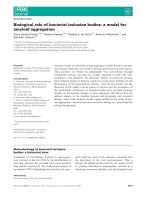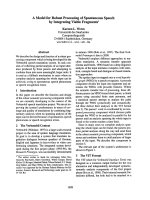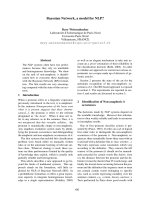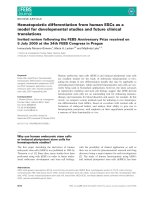A model for predicting radio wave propagation attenuation in rectangular coal mine tunnels
Bạn đang xem bản rút gọn của tài liệu. Xem và tải ngay bản đầy đủ của tài liệu tại đây (357.25 KB, 5 trang )
ISSN 1859-1531 - THE UNIVERSITY OF DANANG, JOURNAL OF SCIENCE AND TECHNOLOGY, NO. 11(84).2014, VOL. 2
71
A MODEL FOR PREDICTING RADIO WAVE PROPAGATION ATTENUATION
IN RECTANGULAR COAL MINE TUNNELS
MƠ HÌNH DỰ BÁO SUY HAO TRUYỀN SĨNG TRONG HẦM MỎ THAN HÌNH CHỮ NHẬT
Nguyen Van Tai, Lam Hong Thach, Nguyen Hoang Hai
Hanoi University of Science and Technology;
Email: , ,
Abstract - Studying the factors that affect radio wave path loss in
coal mine tunnels is of great importance in building a radio
communication system in coal mine tunnels. In this paper, we
propose using a model of evaluating radio wave propagation path
loss in rectangular mine tunnels with factors affecting wave
propagation attenuation including signal frequency, tunnel sizes,
electric parameters of top-floor and side walls of the tunnel. The
model has also been tested via actual measurement in two 100mlong rectangular mine tunnels. The first one has the width w of 6m
and the height h of 3m. The other has the width w of 3 m and the
height h of 1.7m at the frequency of 900 MHz and 2.4 GHz. The
actual measurement results completely correspond to the model
we have proposed.
Tóm tắt - Nghiên cứu các yếu tố ánh hưởng đến suy hao truyền
sóng trong hầm mỏ là hết sức quan trọng để xây dựng một hệ
thống thông tin vô tuyến trong các hầm mỏ than. Trong bài báo
này, chúng tôi đề xuất sử dụng mơ hình đánh giá suy hao truyền
sóng trong hầm mỏ than hình chữ nhật với các yếu tố ảnh hưởng
đến suy hao truyền sóng là tần số thơng tin, kích thước hầm mỏ,
thơng số điện của trần-sàn và bức tường hai bên của đường hầm.
Mơ hình cũng được kiểm nghiệm bằng đo đạc thực tế trong hầm
mỏ có chiều dài 100m; kích thước chiều rộng w=6m, chiều cao
h=3m và hầm mỏ có kích thước chiều rộng w=3m, chiều cao
h=1.7m tại tần số 900 MHz và 2.4 GHz. Kết quả đo đạc thực tế
hoàn toàn phù hợp với mơ hình mà chúng tơi đề xuất.
Key words - rectangular coal mine tunnel; radio waves propagation;
path loss; wireless communication; electromagnetic waves.
Từ khóa - hầm mỏ than chữ nhật; lan truyền sóng; suy hao; truyền
thơng khơng dây; sóng điện từ.
1. Introduction
Vietnam is a country owning very large scale mineral
mining industry. In each coal mine tunnel, for example in
Khe Cham 3, there are hundreds of miners working in
thousands of meter long underground tunnels every day.
Therefore, researching to build a radio communication
system in mine tunnels has attracted the attention of many
researchers. Since the environment inside tunnels is very
complex, it is necessary to accurately assess factors
affecting the propagation loss in coal mine tunnels in order
to build a radio communication network efficiently.
Popular mine tunnel shapes are rectangle, circular and
arched. There have been a lot of researches on the
characteristics of radio wave propagation in various kinds
of tunnel with the different sizes. Mr. A.G.Emslie [4] built
an attenuation model due to wave polarization, the
influence of the surface roughness inside tunnels and the
slope of tunnel based on Maxwell's equations. Y.P.Zhang
[5] also proposed a model predicting wave propagation
attenuation in rectangular tunnel. He split the tunnel into
two zones distinguished by a break point. Each attenuation
zone is affected by free space and the electrical parameters
of walls and top-floor of the tunnel, tunnel size and
frequency of signal. Research on wave propagation
attenuation in cylindrical mine tunnels [6, 7], in arched one
[8] pointed out that various curve of mines, mine size,
frequency of signal, material of walls tunnel influence
propagation wave loss are different.
In order to design radio wave communication systems
in mine tunnels in Vietnam, in this paper we propose using
a model of predicting propagation wave path loss including
propagation wave path loss in free space and other factors
affect for rectangular coal mine tunnel. We also simulate
and analyze factors affecting radio wave propagation
attenuation. Simultaneously authors tested it by measuring
two types of mine tunnel with popular size used in Quang
Ninh – Vietnam mine area. The model predicting radio
wave propagation loss mentioned throughout this paper
serves as a base to build a radio communication system
which can runs effectively in mine tunnels in general and
Khe Cham – Quang Ninh particularly.
2. Mine Tunnel Structure and Model of Radio Wave
Propagation Attenuation
2.1. Mine tunnel structure
Mine tunnels studied in this paper are considered
equivalent to rectangular dielectric waveguide.
Its
structure is described in Figure 1.
Figure 1. Structure of rectangular waveguide
w is the width (m), h is the height (m) of a mine tunnel,
two walls and top of the mine tunnel are made of material
with conductivity of , permeability coefficient of , 1,
and 2, respectively are relative dielectric constant of two
walls and top – floor of mine tunnel. The atmosphere inside
mine tunnels is dry air with dielectric constant of 0 and
magnetic permeability coefficient of 0.
2.2. Model of radio wave propagation attenuation
Radio wave propagation loss in mine tunnel environment
is due to the effect of free space, its height and width, electric
parameter of tunnel walls, its top – floor, horizontally and
vertically polarized waves [9,10]. Therefore, we propose
72
Nguyen Van Tai, Lam Hong Thach, Nguyen Hoang Hai
x is horizontal, y is vertical and d is the length of mine
tunnel road.
If k1 and k2 satisfy transmitting conditions:
k1
,k 2
w
h
Then k1, k2, k3 are connected as follows:
k12 + k22 + k32 =
4 2
2
(5)
(6)
is wave length.
Because the walls of mine tunnels are made of steel
concrete and boundary condition at y=h/2, the tangent of
electric field E and magnetic field H is continuous [11].
Therefore, coefficient k2 is written as
i
(7)
k2 = +
2
h h 2, − 1
Likewise, with the given boundary condition of x=w/2,
the coefficient k1 is written as
i
(8)
k1 = +
w w2 1, − 1
Two equations (7) and (8) show that wave transmitting
regime in mine tunnels is similar to that in metal
waveguide. There is only one difference that is waves
spreading in mine tunnels have a virtual component. This
is because while wave rays inside metal waveguide are
reflected totally, one part of waves spreading in mine
tunnels are absorbed, refracted and they are reflected partly
only. Substitute (7) and (8) for (6), we have:
k3 = k0 −
i
1
(
+
)
3
,
3
2 w 1 − 1 h 2, − 1
2
,
1
In order to get the attenuation rate of vertical polarized
wave, we swap positions between w and h, 1, and 2, :
Ev = 4.343 2 d (
1
,
+ 3 , 2 1/ 2 )
1/ 2
w ( − 1)
h ( 2 − 1)
3
,
1
(11)
Attenuation function comprises horizontally and
vertically polarized wave attenuation. It depends on the
communication frequency parameter, the height (h) and
width (m) of the mine tunnel, relative dielectric constant of
its two walls 1, and its top-floor 2, .
3. Measurements and Analyses
3.1. Simulation and analyses
When we study mine tunnels in Khe Cham – Quang
Ninh, we notice two kinds of mine tunnel size. The main
tunnel road has the height h of 3m and the width w of 6m.
Tunnel road branches are 1,7m high and 3m long. Each
tunnel road branch has the average length of 80 – 100m.
Since its two walls and top are made of steel concrete, the
relative dielectric constant of the two walls is 1, = 5 and
that of the top-floor is 2, = 7. During the process of
simulating, we suppose that the gains of transmitting
antenna Gt and receiving antenna Gr are 1dBi.
Figure 2 demonstrate the simulating result of wave
propagation loss by horizontal and vertical polarization
when the distance between transmitter and receiver is 50m,
the main mine tunnel is 3m-high, 5m-wide and the branch
one is 1,7m-high, 3m-wide. The simulation result shows
that at the frequency smaller than 1.5 GHz, the wave
propagation attenuation of vertical polarization is much
greater than that of horizontal polarization in various tunnel
sizes. And if the height size is far different from the width
one, the rate of attenuation percentage has quite a huge
variation. At the frequency of 900 MHz, the mine tunnel
with the width w of 3m, height h of 1.7m has the wave
propagation loss of -55dB. When the width is 6m, the
height is 3m, the attenuation is -65dB. This proves that if
the radio communication network in rectangular mine
tunnel using the frequency smaller than 1.5 GHz, the rate
of attenuation due to tunnel size is very high.
-10
-20
w=3m, h=1.7m
-30
Attenuation (dB)
that the function of radio wave propagation attenuation in
rectangular mine tunnels composes of attenuation due to free
space and above parameters:
.Gt Gr
PL[dB] = 20 log10 (
) + .d (dB)
(1)
4. .d
In there, is working wave length, Gt, Gr are gains of
transmitting and receiving antennas, d is distance between
transmitting and receivers, is attenuation function in
decibel.
If we regard rectangular mine tunnels as rectangular
dielectric wave guide, the boundary condition which is the
tangent of continuous electric field and magnetic field at
two sides of wave guide will satisfy horizontally and
vertically polarized electromagnetic components in
Maxwell equation:
Ex = E0 cos k1 x cos k2 y.exp(−ik3 d )
(2)
Ey = 0
(3)
Ed = (ik1 / k3 ) E0 sin k1 x cos k2 y.exp( −ik3 d )
(4)
PLh: w=3m, h=1.7m
PLv: w=3m, h=1.7m
PLh: w=6m, h=3m
PLv: w=6m, h=3m
-40
-50
(9)
-60
The virtual component of k3 shows the rate of radio
wave propagation attenuation by distance d. So, the
attenuation rate of horizontally polarized wave Eh is [4]:
Eh = −8.686 Im(k3 )
,
1
Eh = 4.343 2 d ( 3 , 1 1/ 2 + 3 ,
(10)
w (1 − 1)
h ( 2 − 1)1/ 2
-70
w=6m, h=3m
-80
0.5
1
1.5
Frequency (GHz)
2
Figure 2. Wave propagation path loss by frequency at the
distance between transmitter and receiver of 50m
2.5
ISSN 1859-1531 - THE UNIVERSITY OF DANANG, JOURNAL OF SCIENCE AND TECHNOLOGY, NO. 11(84).2014, VOL. 2
40
PLh: w=6m, h=3m
PLv: w=6m, h=3m
PLh: w=3m, h=1.7m
PLv: w=3m, h=1.7m
20
Attenuation (dB)
0
-20
-30
-40
-50
-60
-80
-20
-80
-100
0.5
1
1.5
Frequency (GHz)
2
2.5
Figure 3. Radio wave propagation attenuation by frequency at
the distance between transmittes and receiver of 100m
-10
PLh: w=3m, h=1.7m
PLv: w=3m, h=1.7m
PLh: w=6m, h=3m
PLv: w=6m, h=3m
-20
-30
-40
-50
-60
-70
0
0
20
40
60
Distance (m)
80
100
Figure 5. Wave propagation attenuation by distance (0-100)m
at the frequency of 2.4 GHz
-40
-80
PLh:w= 3m, h=1.7m
PLv: w=3m, h=1.7m
PLh: w=6m, h=3m
PLv: w=6m, h=3m
-70
-60
Attenuation (dB)
From the above analyses, we choose the frequency of
2.4 GHz to simulate wave propagation loss prediction in
different size tunnels as shown in figure 5. It is clear that at
the frequency of 2.4 GHz, the wave attenuation in two mine
tunnels with different sizes and the attenuation rate of
horizontal and vertical polarization are equivalent.
Attenuation (dB)
However, at the frequency band of 1.5 GHz - 2.5 GHz,
wave propagation attenuation of horizontal and vertical
polarization in different tunnel sizes are equivalent. At the
frequency of 2.4 GHz, the propagation is -73dB.
Keeping the parameter values of Figure 2, we change
the distance between the transmitter and the receiver into
100m to get the simulation result as shown in Figure 3.
Figure 3 says that wave propagation loss at the distance
between transmitter and receivers of 100m and frequency
of 2.4 GHz of two different size mine tunnels are both
about -78dB. So we can come to a conclusion that if radio
communication network in rectangular mine tunnels uses
the frequency of 2.4 GHz, the rate of attenuation affected
by the tunnel size is insignificant.
73
20
40
60
Distance (m)
80
100
Figure 4.Wave propagation loss by distance (0-100)m at 900 MHz
At the frequency of 900 MHz (Figure 4) and the
distance between the transmitter and the receiver smaller
than 20m, the rate of wave propagation loss in two different
size mine tunnels are equivalent. The horizontally and
vertically polarized wave loss are the same too. However,
if the distance is bigger than 20m, the wave propagation
loss of horizontal and vertical polarization shows a great
variation. When it is bigger than 50m, the effect of tunnel
size on wave propagation attenuation starts increasing.
3.2. Analyses of actual measurement and comparison
with theoretical model
To test the accuracy of the model of predicting radio
wave propagation loss in proposed rectangular mine
tunnels, we carried out measuring the rate of wave
propagation attenuation in the main mine tunnel with the
width w of 6m, height h of 3m and the tunnel branch with
the width w of 3m and the height h of 1.7m. They are the
parameters of Khe Cham mine tunnel located in Quang
Ninh province. The frequency there is put at 900 MHz and
2.4 GHz. The equipment for testing is the HP 44233B
signal generator which is used as a transmitter operating in
the frequency band 900 MHz – 2.5 GHz and transmitting
capacity of -70dB. The equipment measuring signal
intensity R/S ESV is used as a signal receiver. We placed
the transmitter at the beginning of the tunnel road. The
receiver is moved from the start to the end of the road.
We have tested a main tunnel which is 6m-wide and
3m-high and a branch tunnel which is 3m-wide and 1.7mhigh at the frequency of 2.4 GHz. The test results are
recorded and shown in figure 6 and 7.
Figures 6 and 7 indicate that measurement results
match perfectly with the proposed model. When the
receiver is located 20m far from the transmitter in the main
tunnel road (w=6m, h=3m) and in the tunnel road branch
(w=3m, h=1.7m), the attenuation rate respectively is 60dB and -59 dB. If the distance is 40m, the rate is -67.5
dB and -64,3dB in turn. If the distance is 60m, the rate is
-68.6 dB and -67.3 dB accordingly. Nevertheless, when
the receiver is moved to the distance of 70-100m from the
transmitter, we can not receive any signal from the
transmitter which is put at the beginning of the tunnel
road in two types of the tunnel road. This is because the
transmitting capacity of transmitter for testing is -70dB.
This also helps prove that proposed model is suitable.
74
Nguyen Van Tai, Lam Hong Thach, Nguyen Hoang Hai
-10
PLh: Simulation
PLv: Simulation
Measurements
-20
-40
Attenuation (dB)
-60
-70
-80
-90
0
20
40
60
Distance (m)
80
100
Figure 6. Comparison between measurement results and simulation
of radio wave propagation attenuation prediction by distance (0100)m at the frequency 2.4 GHz in Khe Cham – Quang Ninh mine
tunnel with the width of 6m and the height of 3m
-20
-40
-30
-40
-50
-60
-70
-80
0
20
40
60
Distance (m)
80
100
Figure 8. Comparison between measurement result and
simulation of radio wave propagation attenuation prediction by
distance (0-100)m at the frequency of 900 MHz in Khe Cham –
Quang Ninh mine tunnel which has the width of 6m and the
height of 3m
PLh: Simulation
PLv: Simulation
Measurements
-30
Attenuation (dB)
PLh: Simulation
PLv: Simulation
Measurements
-20
-50
-10
-50
PLh: Simulation
PLv: Simulation
Measurements
-20
-60
-70
-80
-90
0
20
40
60
Distance (m)
80
100
Figure 7. Comparison between measurement results and simulation
of radio wave propagation attenuation prediction by distance (0100)m at the frequency of 2.4 GHz in Khe Cham – Quang Ninh
mine tunnel with the width of 3m and the height of 1.7m
We took the same test for a tunnel road which has the
width of 6m and the height of 3m and another tunnel road
which is 3m-wide and 1.7m-high at the frequency of 900
MHz. Its result is described in Figures 8 and 9.
The results in Figures 8 and 9 show that the proposed
model fits the reality. However, at the mine tunnel with the
width of 6m and the height of 3m, when the receiver is
located 80-100m far from the transmitter, there is no signal
anymore. In case of the tunnel road branch with the width
of 3m and the height of 1.7m, the attenuation rate recorded
at the place which is 100m far from the transmitter is -63.5
dB. This proves that proposed theoretical model matches
the reality.
The actual measurement results in both the main tunnel
and the tunnel road branch at 900 MHz and 2.4 GHz show
that the proposed model is absolutely suitable. But this
model also says that while designing radio communication
system in mine tunnels, if we use the frequency band 2 GHz
Attenuation (dB)
Attenuation (dB)
-30
- 2.5 GHz in various size tunnels, the attenuation rate is the
same. If we use the frequency of 900 MHz, the propagation
varies enormously. This leads to trouble for calculating and
designing the radio communication system effectively.
-10
-30
-40
-50
-60
-70
0
20
40
60
Distance (m)
80
100
Figure 9. Comparison between measurement results and simulation
of radio wave propagation attenuation prediction by distance (0100)m at the frequency of 900 MHz in Khe Cham – Quang Ninh
mine tunnel with the width of 3m and the height of 1.7m
4. Conclusions
The model of radio wave propagation attenuation
prediction proposed in this paper is a general one which
calculates radio wave propagation attenuation along the
length of the tunnel. It comprises attenuation due to free
space, the influence of tunnel size, the electric parameter
of tunnel wall material and wavelength of signal. The
model shows that at the frequency smaller than 1.5 GHz,
the wave propagation loss depends much on tunnel size.
Simultaneously, propagation by horizontal and vertical
polarization varies much. At the frequency band 1.5 GHz 2.5 GHz, radio wave propagation attenuation due to tunnel
size and propagation loss due to horizontal and vertical
ISSN 1859-1531 - THE UNIVERSITY OF DANANG, JOURNAL OF SCIENCE AND TECHNOLOGY, NO. 11(84).2014, VOL. 2
polarization is insignificant. This model is perfectly
suitable to the characteristics of mine tunnels. And it is a
basis for building radio communication systems which
operate in mine tunnels in Vietnam.
REFERENCES
[1] M.Ndoh and G.Y.Delisle, “Underground mines wireless propgation
modeling”, 60th IEEE Vehicular Technology Conference, Los
Angeles, CA, 3584-3588, 2004.
[2] M.Lienard and P.Degauque, “Natural Wave Propgation in mine
Environment”, IEEE Transaction on Antennas and Propagation, 2:
540-549, 2008.
[3] M.Boutin, A.Benzakour, C.Despins and S.Affes, “Radio wave
characterization and modeling in underground mine tunnels”, IEEE
Transaction on Antennas and Propagation, 48(9): 1326-1339, 2000.
[4] A. G. Emslie, R. L. Lagace and P. F. Strong, "Theory of the
propagation of UHF radio waves in coal mine tunnels", Proc.
Through-the-Earth Electromagnetics Workshop, 1973.
[5] Y.P.Zhang, “Novel Model for Propagation Loss Prediction in
Tunnels”, IEEE Transactions On Vehicular Technology, Vol.52,
No.5, September 2003.
75
[6] Kamran Arshad, Ferdinand Katsriku, and Aboubaker Lasebae
“Effects of Different Parameters on Attenuation Rates in Circular
and Arch Tunnels” PIERS Online, Vol. 3, No. 5, 2007, pp: 607-611.
[7] C.L. Holloway, D.A. Hill, R.A. Dalke, et al., Radio wave
propagation characteristics in lossy circular waveguides such as
tunnels, mine hafts, and boreholes, IEEE Transactions on Antennas
and Propagation 48 (2000) 1354–1366.
[8] Zhang Chang-sen, Research on propagation characteristics of
electromagnetic wave in tunnels with arbitrary cross sections, Future
Computer and Communication (ICFCC), 2010 2nd International
Conference on (Volume:1 ).
[9] Nagendra Sah, “Optimization of Parameters for Minimum Path
Loss in Underground Tunnels Using CSP”, IJEAT, 2012.
[10] Andrej Hrovat, “Path Loss Analyses in tunnels and Underground
Corridors”, International Journal Of Communications, Issue 3,
Volume 6, 2012.
[11] Shuqi Wang, “Radio Wave Attention Character in the Confined
Environments of Rectangular Mine Tunnel”, Modern Applied
Science, Vol.4, No.2, February 2010.
(The Board of Editors received the paper on 23/09/2014, its review was completed on 29/10/2014)









